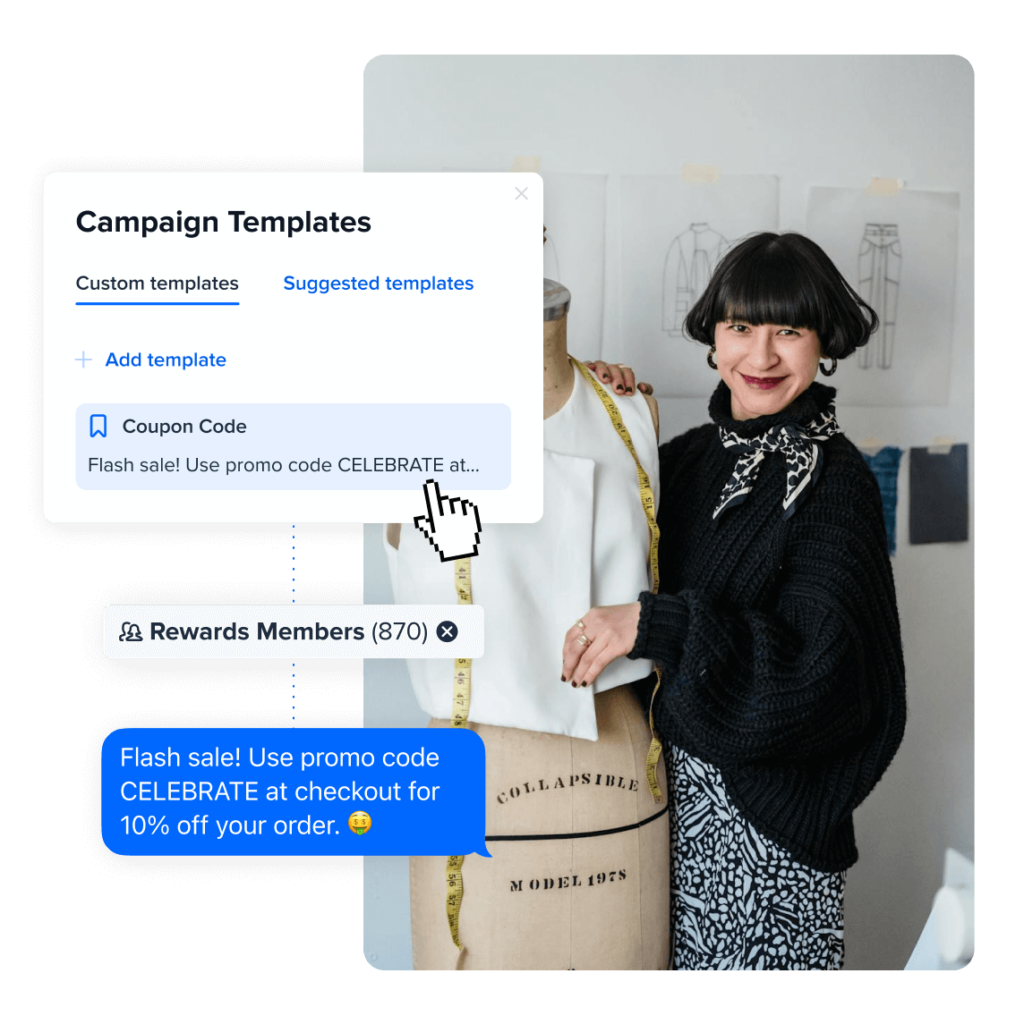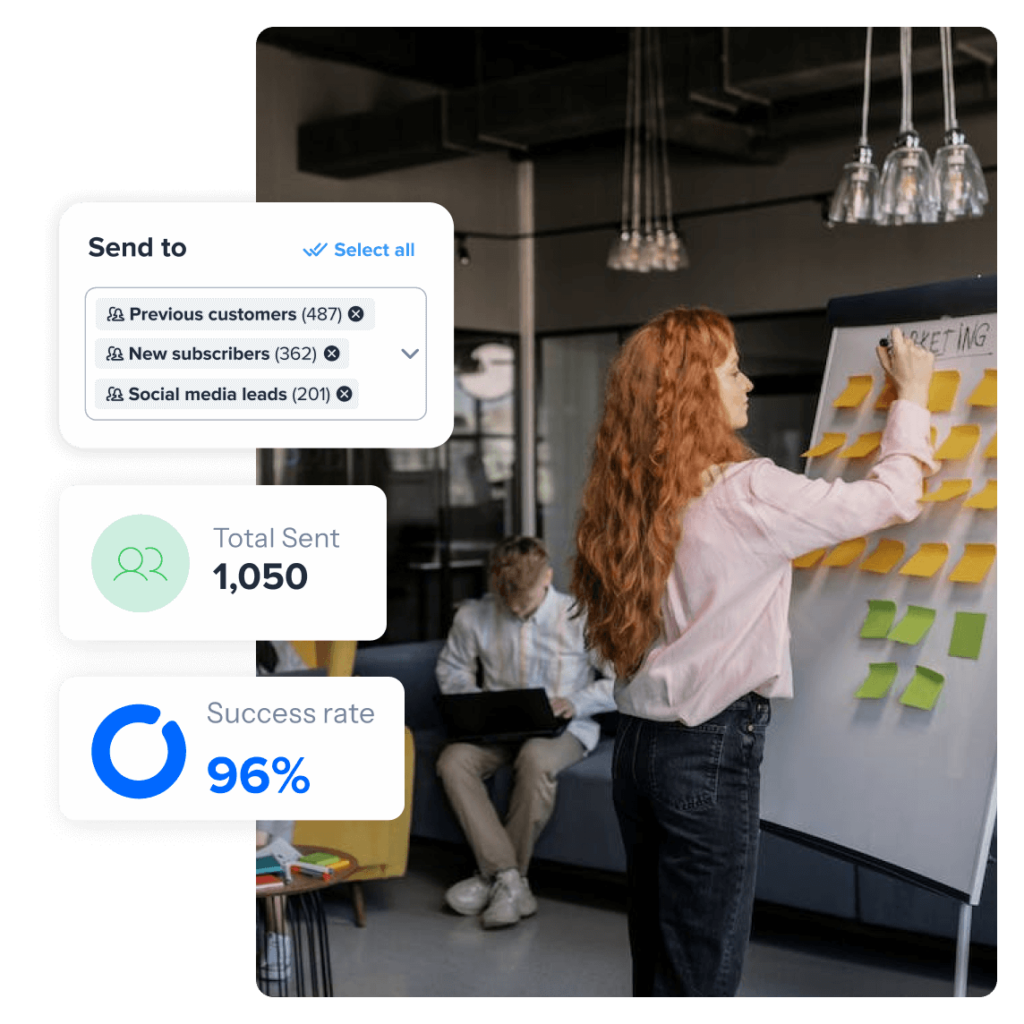

Business text messaging has transcended personal conversations to become a vital tool in modern corporate communications and customer engagement. Whether you’re a small business owner or part of a large corporation, understanding how business text messaging, SMS business communications, and corporate messaging solutions work can transform your approach to customer service, marketing campaigns, and internal communication workflows.
This comprehensive guide explores what business text messaging entails and demonstrates how SMS business communications, mobile messaging, and enterprise texting solutions can enhance customer interactions, streamline organizational communications, and boost operational efficiency through proven messaging strategies and omnichannel communication best practices.
Table of Contents
Business text messaging is a company’s use of SMS (Short Message Service) and MMS (Multimedia Messaging Service) to communicate with customers, prospects, and employees via an A2P SMS platform. It powers marketing, customer service, and operations by delivering fast, reliable, and trackable mobile messages at scale through short codes, 10DLC numbers, or toll‑free texting.
Companies implement SMS marketing platforms and enterprise texting solutions to send timely promotions, operational updates, and critical alerts to customers, thereby enhancing engagement rates and customer service quality. Compared with MMS, which supports rich media, SMS is best for concise text (typically 160 GSM‑7 characters or 70 with Unicode) and can be concatenated for longer content, while MMS supports images, GIFs, video, and longer captions within carrier size limits.
By integrating business text messaging into their communication strategies, organizations can enhance operational efficiency while cultivating stronger customer relationships and maintaining a dynamic, connected workforce. Whether you deploy cloud-based business messaging software or connect on‑premise systems via APIs and webhooks, this integration creates measurable improvements in response times, customer satisfaction scores, and overall business performance metrics.
How it works in practice: A2P messages are submitted from your SMS platform to an SMSC, vetted by carriers (including 10DLC campaign registration), and delivered to handsets with delivery receipts, STOP/HELP keyword handling, and robust compliance logging. Teams often integrate CRM, marketing automation, and ticketing tools to sync contacts, segment audiences, and orchestrate omnichannel communication.
Understanding how business text messaging aligns with specific organizational objectives enables companies to maximize their return on investment. The following sections explore three primary applications that demonstrate the versatility and effectiveness of SMS business communications across informational, transactional, and conversational use cases.
SMS marketing campaigns for businesses deliver timely offers, exclusive discounts, and event alerts directly to customers’ mobile devices, ensuring high visibility and engagement rates. This direct communication channel enables quick dissemination of key marketing messages, which increases sales opportunities and drives immediate customer action while improving campaign attribution and conversion tracking.
Text message marketing strategies prove particularly effective because they bypass crowded email inboxes and social media feeds. Mobile marketing automation tools allow businesses to schedule campaigns, segment audiences, and track performance metrics in real-time, creating data-driven optimization opportunities such as A/B testing, send-time optimization, and targeted follow-ups for opt-in keyword campaigns and list growth.
Visual example: The image below illustrates how a small retailer uses business text messaging to promote limited-time offers and build a high-intent subscriber list—an approach that consistently outperforms email for click-through rate and same-day revenue.

Tip: For stronger topical authority, align SMS marketing campaigns with related assets like your SMS marketing strategy guide, promotion calendar, and loyalty program messaging to create a cohesive, omnichannel journey.
SMS customer support enhances customer service operations by providing a quick and convenient communication channel for support queries. This text-based customer service approach allows customers to receive instant responses to inquiries, automated appointment reminders, and real-time updates on service status, which improves satisfaction scores, shortens handle time, and reduces call center volumes.
Business messaging customer care systems integrate with existing CRM platforms to maintain conversation history and ensure consistent service quality. Automated customer service texts handle routine inquiries, freeing human agents to focus on complex issues that require personal attention while improving CSAT, SLA adherence, and first-contact resolution through intelligent routing and canned responses.
The screenshot above shows a two-way texting workflow for appointment scheduling—an example of automated appointment reminders that cut no‑show rates and reduce inbound call volume while maintaining a friendly, conversational experience.
For internal team communication, business text messaging supports rapid dissemination of critical information, urgent alerts, and last-minute schedule changes. This immediate communication capability ensures all team members receive important updates promptly, regardless of their physical location or work schedule, and complements workforce management platforms.
HR departments leverage text messaging to send shift reminders, policy updates, and emergency notifications because these messages achieve higher open rates than email communications. This immediacy significantly improves operational efficiency and team coordination across multiple locations or remote work environments, and it aids with shift swaps, training reminders, and new-hire onboarding touchpoints.

In practice, HR broadcast messages can reach deskless employees instantly—ideal for weather closures, compliance reminders, or last‑minute shift coverage—while preserving an auditable communication trail.
Pro tip: Map employee journeys (onboarding, training, benefits enrollment) and trigger timely SMS nudges integrated with your HRIS or scheduling app to reduce drop-off and improve completion rates.
Business SMS benefits extend far beyond simple message delivery, offering measurable advantages that directly impact bottom-line results. As a direct and widely accessible communication tool, SMS marketing advantages and business communication efficiency gains include the following key performance indicators and outcomes:
These quantifiable benefits demonstrate why businesses across industries adopt SMS as a core component of their communication strategy, resulting in improved customer engagement metrics and operational efficiency gains. For decision support, benchmark your own program with an ROI calculator and compare SMS performance against email, paid social, and push notifications.
Business messaging platforms implement comprehensive security measures to protect sensitive user data and maintain regulatory compliance. These security protocols include end-to-end encryption, TLS in transit, AES‑256 at rest, secure data storage with SOC 2 Type II certification, SSO/MFA, role-based access controls, data retention controls, and regular third-party security audits that ensure messages and customer information remain protected against unauthorized access and data breaches.
Companies using SMS or MMS services must comply with multiple data privacy laws and regulations, including the Telephone Consumer Protection Act (TCPA), General Data Protection Regulation (GDPR), and Health Insurance Portability and Accountability Act (HIPAA) for healthcare organizations, alongside industry standards such as CTIA messaging guidelines and carrier-specific A2P 10DLC vetting. These regulations mandate obtaining explicit written consent before sending promotional messages, maintaining detailed records of this consent, and providing clear opt-out mechanisms.
There are 9 essential components that businesses must implement to keep their text messaging compliant with federal and state regulations:
Research shows that 71% of consumers expect businesses to deliver personalized experiences, making text messaging an ideal channel to achieve this goal. To create effective personalized messaging campaigns, businesses should systematically capture relevant customer information, including purchase history, browsing behavior, demographic data, and previous interaction patterns—and align these with customer journey mapping across channels.
This comprehensive data collection enables integration with Customer Relationship Management (CRM) systems and advanced analytics platforms that analyze interaction patterns and predict customer preferences. By leveraging this customer intelligence, businesses can craft highly targeted messages that address individual needs and interests, resulting in increased relevance, higher response rates, and improved customer lifetime value.
Personalized message strategies include product recommendations based on purchase history, location-based offers when customers are near retail locations, birthday and anniversary promotions, and abandoned cart recovery messages. These targeted approaches consistently outperform generic messaging by 2-3x in terms of engagement and conversion rates, especially when combined with omnichannel communication and timely follow-ups.
Quick answer for voice search: Businesses should use text messaging because it delivers near‑instant reach, exceptional engagement rates, and measurable ROI while supporting both marketing and customer service with minimal friction.
This example illustrates a segmented, trigger-based campaign that sends a personalized offer after a user browses a product—demonstrating how mobile messaging complements email and push notifications in a unified lifecycle strategy.
Multimedia Messaging Service (MMS) capabilities allow businesses to send engaging multimedia content, including high-resolution images, videos, audio files, and interactive elements that enhance the communication experience. This rich media functionality proves particularly valuable for marketing campaigns requiring visual product demonstrations, instructional content that benefits from step-by-step visual guides, and customer support scenarios where visual troubleshooting significantly improves resolution times. RCS (Rich Communication Services) is also emerging, offering app-like buttons and read receipts on supported devices.
By incorporating multimedia elements, businesses create more impactful and memorable customer experiences that lead to higher engagement rates, improved message recall, and enhanced customer retention. MMS messages achieve 8x higher engagement rates compared to text-only SMS because visual content captures attention more effectively and communicates complex information more efficiently.
The example above shows how MMS pairs imagery with concise copy to boost conversion—ideal for product drops, seasonal launches, and time-sensitive promotions.
Artificial intelligence tools, such as SimpleTexting’s AI Assist, revolutionize SMS campaign effectiveness by generating valuable, actionable, and brand-consistent messages through advanced natural language processing algorithms. With simple prompt inputs, AI Assist produces five original text message variations, enabling both new marketers and seasoned professionals to optimize their messaging strategies, increase click-through rates, and improve overall campaign ROI through data-driven content creation and rapid A/B testing.
Beyond serving as an AI text message generator, these machine learning tools analyze customer response patterns and automatically refine one-to-one messages sent to individual contacts through your messaging platform. This automated optimization ensures consistent message quality while maintaining personalized communication at scale, with features like intent detection, conversation summarization, and predictive send-time optimization.
To maximize the potential of your business text messaging efforts and ensure sustainable success, implement these evidence-based best practices that align with industry standards and regulatory requirements:
Always secure explicit, documented consent from recipients before initiating any text communication, and implement user-friendly opt-out mechanisms that process requests immediately. This approach not only ensures compliance with TCPA and state regulations but also demonstrates respect for customer preferences, builds long-term trust, and reduces the risk of spam complaints that could damage your sender reputation.
SMS messages have a 160-character limit for optimal delivery, so craft straightforward and concise content that delivers immediate value. Every message should provide something meaningful—whether it’s an exclusive offer, important service update, or useful information—and must be relevant to the recipient’s interests or previous interactions with your business.
Leverage existing customer data from your CRM system to create personalized text messages that address recipients by name and reference their specific preferences, purchase history, or behavioral patterns. This personalization strategy can increase engagement rates by up to 300% because customers respond more favorably to messages that feel tailored to their individual needs and interests.
Send text messages during reasonable business hours (typically 8 AM to 9 PM) while considering recipients’ time zones and local regulations. Avoid early morning, late evening, or weekend messaging unless you’re sending time-sensitive information that customers specifically requested, such as appointment reminders or emergency alerts.
Every text message should contain a specific, actionable call to action that guides recipients toward the desired next step. Whether you want customers to visit your website, call your business, use a promotional code, or schedule an appointment, make the action clear and easy to complete while providing measurable ways to track campaign effectiveness and customer response rates.
Pro tip: Keep URLs short, identify your brand in the first 30–40 characters, and test message previews across iOS and Android for readability and link wrapping.
Business text messaging applications span across multiple industries and use cases, demonstrating the versatility and effectiveness of SMS as a communication channel. Companies successfully implement text messaging for the following strategic purposes across healthcare, retail, hospitality, education, real estate, professional services, and nonprofit organizations:
For example, Bella Santė, a day med spa in Boston, implemented SimpleTexting’s business messaging platform for targeted marketing campaigns. They discovered that business text messaging creates an easy pathway to develop more personalized relationships with their customers through direct, immediate communication. Within just a few months of implementation, Bella Santė’s marketing subscriber list expanded to over 200 engaged customers, resulting in a 25% increase in appointment bookings and noticeable gains in rebooking rates.
Similarly, Pallas Seeds, an agricultural supply company, adopted SimpleTexting’s platform to deliver time-critical updates about field conditions and seed availability to their farming customers. They found that text messaging provides a convenient communication method that allows customers to review important information at optimal times, eliminating the need for individual phone calls to each customer. Since implementing business text messaging, Pallas Seeds reports increased trust and customer satisfaction because farmers receive timely, relevant information that directly impacts their planting decisions.
Additional high-performing applications include admissions reminders for education, guest communications for hotels, property tour scheduling for real estate, and curbside pickup updates for retail—each benefiting from fast delivery and two-way messaging.
Like most communication technologies, business text messaging continues evolving through advanced technological integrations and changing consumer expectations. In recent years, artificial intelligence and machine learning integration has enabled automated text messaging systems that create context-aware responses, predictive message timing, and enhanced personalization capabilities that adapt to individual customer behavior patterns.
Looking ahead, business text messaging will incorporate more sophisticated analytics platforms for understanding user engagement patterns, predictive messaging algorithms that anticipate customer needs before they arise, and advanced chatbot integration that provides instant, intelligent responses to customer inquiries. The technology will increasingly focus on interactive elements, such as in-message purchasing capabilities, appointment scheduling widgets, and real-time customer service chat features that improve engagement and streamline customer experiences.
To stay competitive and embrace these emerging trends, businesses should proactively adopt new messaging features as they become available, particularly Rich Communication Services (RCS), which offers enhanced multimedia capabilities, read receipts, and interactive buttons that create app-like experiences within text messages.
Additionally, staying attuned to evolving consumer preferences—such as increased demand for privacy protection, instant response expectations, and seamless omnichannel experiences—will prove crucial for long-term success. Companies that embrace these innovations will leverage text messaging as a dynamic and powerful tool for customer engagement that drives measurable business growth. This guide reflects current best practices through 2025 and should be reviewed quarterly for new benchmarks and regulatory updates.
You can launch your business text messaging strategy successfully by following these 5 proven implementation steps. If you’re asking, “How do I start business texting for my company?” the outline below provides a quick, actionable plan for setup and early wins:
Nathan is the head of content and SEO at SimpleTexting. With the help of an awesome team, he’s attracted more than 65 million website visitors, converted 10 million email subscribers, and supported 300,000 software users. He's written for the likes of Fast Company and his work has been referenced in publications like Forbes. Nathan has 15 years of proven corporate and startup marketing experience and continues to venture off the beaten path. When he’s not marketing, you’ll catch Nathan canoeing in the Boundary Waters or training for his next ultra marathon. Connect with Nathan on LinkedIn.
More Posts from Nathan ElleringFind out if traditional text marketing or a chat bot for business better fits the needs of your organization.
ReadSMS marketing services often have different cost structures. Here are the questions to ask when reviewing them.
ReadStart a text marketing campaign or have a 1-on-1 conversation today. It's risk free. Sign up for a free 14-day trial today to see SimpleTexting in action.
No credit card required